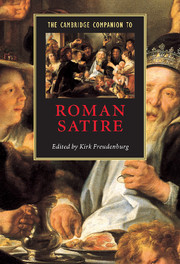Book contents
- Frontmatter
- Introduction
- Part I Satire as literature
- 1 Rome’s first “satirists”
- 2 The restless companion
- 3 Speaking from silence
- 4 The poor man’s feast
- 5 Citation and authority in Seneca’s Apocolocyntosis
- 6 Late arrivals
- 7 Epic allusion in Roman satire
- 8 Sleeping with the enemy
- 9 The satiric maze
- Part II Satire as social discourse
- Part III Beyond Rome
- Conclusion
- Key dates for the study of Roman satire
- Bibliography
- Index
- Series list
6 - Late arrivals
Julian and Boethius
from Part I - Satire as literature
Published online by Cambridge University Press: 28 May 2006
- Frontmatter
- Introduction
- Part I Satire as literature
- 1 Rome’s first “satirists”
- 2 The restless companion
- 3 Speaking from silence
- 4 The poor man’s feast
- 5 Citation and authority in Seneca’s Apocolocyntosis
- 6 Late arrivals
- 7 Epic allusion in Roman satire
- 8 Sleeping with the enemy
- 9 The satiric maze
- Part II Satire as social discourse
- Part III Beyond Rome
- Conclusion
- Key dates for the study of Roman satire
- Bibliography
- Index
- Series list
Summary
Readers of this chapter may be surprised by its Greek content. Verse satire is certainly a Roman genre, but Menippean satire (as a generic term no older than the Renaissance) is a Greco-Roman phenomenon. Its founder and patron saint is the Greek Menippus, a Cynic of the third century bce; the Roman Varro names his literary experiments Saturae Menippeae after his Greek muse. But if we are to understand Menippus at all, we need to speak of Lucian, the prolific Greek belletrist of the second century ce. This Lucian is both a student of Greek literature and an observer of the Roman scene; the fourth century Roman emperor Julian, who writes in Greek and who is influenced in one of his satiric productions both by the Roman Seneca and by the Greek Lucian, helps to illumine both Seneca and the traditions of Menippean satire in late antiquity. These Greeks have a crucial place in this Roman book, for without them the history of Roman satire, both in late antiquity and in the Renaissance, cannot be written.
To extricate a history of the genre of Menippean satire in the classical period from our intractable welter of testimonia, fragments, and imperfectly preserved literary experiments – Varro’s Menippeans, Petronius’ Satyricon, and Seneca’s Apocolocyntosis are all to varying degrees incomplete – is to acknowledge that our data, as frustrating as they are, have also overwhelmed the texts that gave them birth. The little that we can know about Menippus the author, combined with the literary uses to which Lucian puts Menippus, as character as well as author, leads me to the following conclusion: that Menippean satire is a useful name for the epicenter of a range of phenomena, both stylistic and thematic, that in fact evolve over time.
- Type
- Chapter
- Information
- The Cambridge Companion to Roman Satire , pp. 109 - 122Publisher: Cambridge University PressPrint publication year: 2005
- 3
- Cited by

